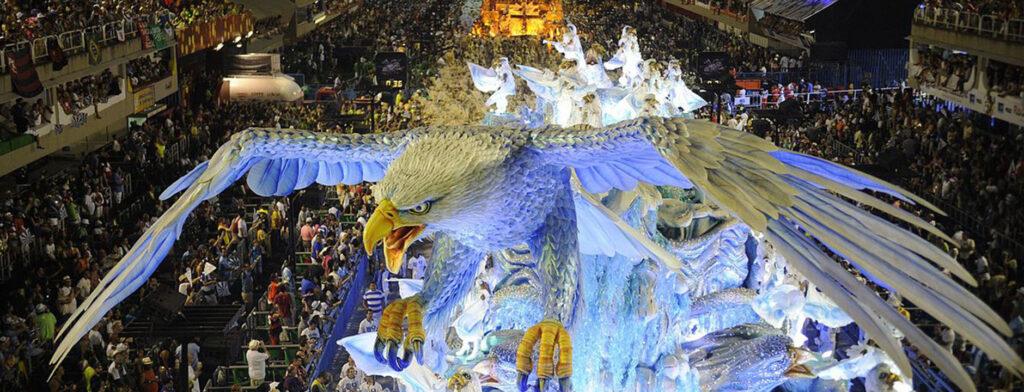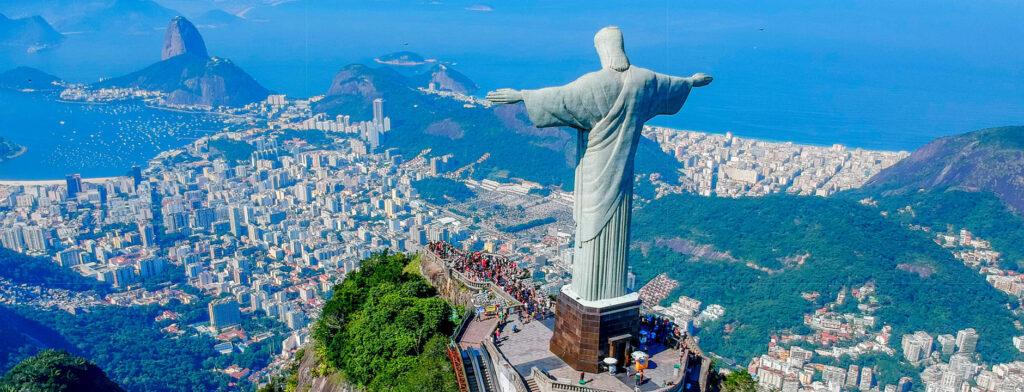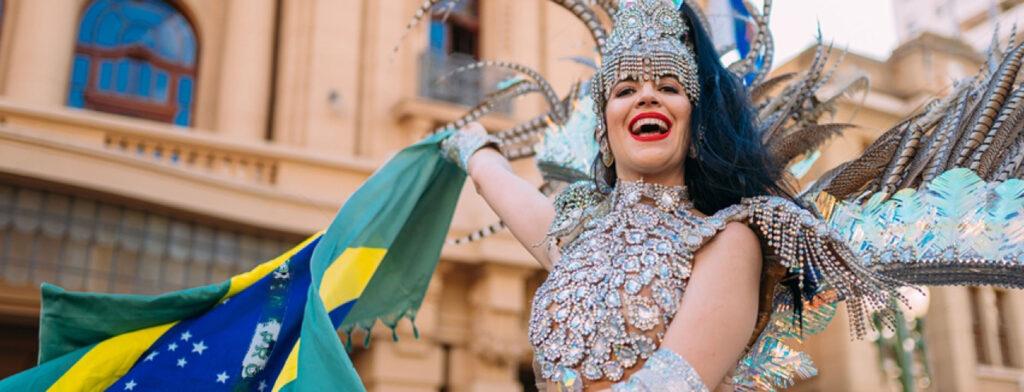What does it mean the celebration of carnival?
Just before starting a diet, you give the last binge. You permit yourself to commit the excesses because, very soon, you will begin the diet. Has it happened to you? Did you know that celebrating carnival is precisely that? Since its beginning, the carnival is the time to allow yourself extravagances and lack of control before Easter. Well, let’s see the Carnival in Rio de Janeiro.
An ancient celebration
It is an ancient celebration, in which the most common trait seems to lose shame. Get rid of that sense of ridicule that distances us on many occasions from fun. A necessary exercise even to face day to day situations.
There is no consensus to explain the origin of the word “carnival.” For some, it comes from the Latin carnem levare which means “to abandon the flesh”. In the strict dietary sense as symbolic, it refers to what you want to do just before you have decided to abandon the formalities. It means the last day of pleasure before starting with the routine of Lent.
It is also said that its name could come from the goddess Karna or the karna god. Translated from Sanskrit, it means ears, for the gold earrings that were used.
What is known with certainty is that carnivals are popular parties of playful nature and fun. The most radical opponents of the carnival – surely religious fundamentalists – refer to it as Carne a Baal (devil) and consider this celebration and what happens in it, sin.
When is carnival celebrated?
The carnival is celebrated just as the Lenten period begins. Forty days before Easter, the same time during which Jesus fasted in the desert. Although it is a pagan festival, it is linked to the religious festivities of Holy Week.
I have always thought that the carnival is a complete sample of all the arts. I mean, art in all its manifestations: plastic, scenic and audio-visual. Who hasn´t enjoy a parade, it is a show that displays art in all its variants: theatre, singing, poetry, dance, painting, sculpture, and many other plastic arts.
I like carnival because it allows me to expand my freedom, it will enable me to show myself without formalities. I spend the year cultivating my identity, but at carnivals, it’s time to stop being me.
Today, the universal way of celebration is a costume parade. Behind every costume and mask, there is an untold story. What story do you have to tell?

Origin of carnival
The roots, according to some historians, could be traced back to more than 5,000 years ago, in ancient Sumer and Egypt. It expanded throughout Europe and was brought to America by Spaniards and Portuguese of the fifteenth century. Nevertheless, surviving elements of pre-Hispanic and African-American old parties are preserved.
Five thousand years ago Sumerians disguised themselves to ask the gods to expel evil spirits and give them the gift of fertility from earth. Since that time, the concept of carnival has evolved and been re-invented.
The parties were held in honor of Bacos, the Roman god of wine. Perhaps because of this reference, his character has always been ludic or pagan.
Since the beginnings, the carnival has been the space of inclusion. Throughout the party, it is not easy to distinguish social hierarchies. We are all the same.
The wealth, the color of the skin, political inclinations, sexual preferences, religious orientations have no representation. It is the histrionics, the talents towards dancing, singing, what distinguish us in these parties.
Symbolisms
Carnival is a symbolic festival; as a whole and in the individualities. Disguising itself implies the representation of a story, real or not; it does not matter. Each of the elements, by themselves, symbolize a reality.
The spiritual world identifies it as a very well-kept secret. A kind of spiritual alchemy. They refer to Carnival as the time to reverse the established order. Moment of the release of the personal and social shadow.
An effervescent time to those repressed, the appearance of the vilest inclinations of the being. According to the spiritualist world, it is a necessary moment to identify darkness, before the encounter of light.
The most critical description defines it as a sinister celebration. Under this approach, the carnival is when the satisfaction of the vices of the vilest characteristics, more familiar to the fallen man, are satisfied. Carnival is like the last binge, the last cigarette before leaving nicotine.
Their majesties: Queen and King of Carnival in Rio de Janeiro
Two characters are fundamental in these celebrations. Carnival parties are usually presided over by the queen and her king Momo. The queen is the maximum symbolic hierarchy of the carnival. Her power is her beauty and charisma. She is the character that leads the parades. Her election as the queen is before the parade and includes the participation of the community.

King Momo is another of the main characters. In Greek mythology, he represents the personality of sarcasm, ridicule and ironic wit. In his designation, beauty is an attribute without vital importance.
Specifically, carnival in Rio de Janeiro, the Garota plays a fundamental role. It is a voluptuous lady with a majestic dance movement synchronized with the music of samba.
For the Garota, the preparation takes many days of training throughout the year. Requires high physical conditions to tolerate hours of a tough dance with movements of hips and legs that demand a lot of energy consumption.
Carnival in Rio de Janeiro
With excellent reasons, Rio de Janeiro is called by the Brazilians the beautiful city. Concentrated in a narrow strip between the ocean and the mountains, Rio is home to about 7 million inhabitants. Permanently receive the embrace of Christ the Redeemer, the most famous monument in Rio, with 38 m in height.

Rio de Janeiro is were the biggest carnival party on the planet is celebrated. Has been described as the ultimate expression of the Brazilians. It is the most famous party on the planet. The celebration of this party has made Rio, the most famous city in Brazil and the world.
The party consists of a two-day parade — a fascinating procession on earth. There, is the identity what is essential. The sense of being Brazilian is dignified.
The spirit arises from the traditions of the first inhabitants of the Amazon. Natives and Africans who contributed with elements of percussion and drums to the music and the. The settlers added the processions in their religious sense.
Economic Repercussion
The most representative carnivals in the world impact on the local ecosystem and their economy. Many enterprises arise and contribute to emerging trade. The adjacent communities spend a good part of their time making costumes, parades (comparsas), rehearsing songs and dances.
Products and services that are only commercialized on those dates fuel the trade related to that festivity. These economic ecosystems, in Rio de Janeiro, were nourished by entrepreneurs who visualized an attractive and very diversified business opportunity. Some of those opportunities are the confection, the mechanization of mobile elements on the parade, makeup, dance classes, technology services, among many others.
To these initiatives, over time, locals have added the resourcefulness to their work, their lives, from a wild and passionate nationalist sense and the daring of the economic trade of Sao Paulo.
The main labor force in the festivity lives in the favelas or slums. Almost all the samba schools are concentrated in those areas. There are people with very precarious economic conditions, who work a good part of the year to win the competition.
On the other side of the city, in the Mangueira´s deposit -one of the most prestigious samba schools- kilometers of fabrics, tons of paint and steel tubes, millions of costumes and costumes are store for the parade. It is an entire industry.
The comparsas – parade – practice their dance and pirouettes for two days, in the sambadrome facility, in a catwalk of 1.5 k long. They do it in front of a panel of 40 judges, in charge of evaluating music, lyrics, costumes, and choreography. The samba schools allow the participation of external people with a prior preparation of about three months.

Rio de Janeiro´s Carnival Parade: the time machine and the fantasies
Watch the show and begin to experience a journey through time. You live each fantasy through.
Immediately, you will be part of their imaginary world displayed in the parade and will dance to the drums, marked by the compass of the hips. It is an infectious rhythm, and there is no way out, surrender and move to the rhythm.
Fantasies are varied in terms of their historical content. They are also diverse in visual richness and movement.
Making a virtual tour through different editions of the Rio carnival, from the passivity of my computer, I could vibrate to the rhythm of the electrifying samba. I was surprised by the multiplicity of stories, and innovations.
I saw air dancers, propelled on swimming pools. The technological deployment is surprising. Innovation and technology have been integrated in such a way to the carnival, that nothing seems illusory.
I also noticed jigging giant animals, some with simple mechanical movements, and others capable of devouring in one bite a stocky dancer. I saw enchanted snakes with the autonomy of action in front of craft fishing boats, which seemed to honor their commercial fishing tradition and the peasant slaughter. The contrast between the stories makes you feel in a vortex of the multi-universe.

At the top of each fantasy, I watched dancers in a balance demonstration that violates the laws of gravity. These are athletic dance routines, due to the physical demands involved.
The carnival is inclusive. I was able to observe comparsas of the disabled making part of this cultural phenomenon.
The visual effects of fantasies can have such a level of applied technology that they can make you doubt reality. Some elaborations can have the size of a medium-sized building, with movements that denote an elaborate semi-industrial mechanics.
Garotas at the Carnival in Rio de Janeiro
The sensuality emanated by garotas is one of the most popular attractions. Una Garota (girl in Portuguese) is a kind of goddess of the dance moving to the rhythm of drums.
Their participation goes even beyond the sensual. The previous preparation is almost pre-Olympic. A mile and a half of hip shaking demand it.

Music is a joint accomplishment. Hundreds of musicians are paced, synchronized to the rhythm of the proper samba.
Fantasies that honor historical events, can lead you to recreate life in the caverns. They can also anticipate the possible future. Some send religious, social, environmental messages. All of them denote the didactic component of the carnival in Rio.
Majesty, creativity, grandeur, will be sensations that you would experience if you decide to be a first-class witness. The brightness, the frost, the lens in conjunction with the bright display, make the substitution to the sun when it is hidden.
In my virtual tour, I was surprised by the image of a rasta, whose hair was more than 2 meters long, was braided between several garotas and dancers. You can easily pass that image, so typical of the suburbs and every day, to the Avengers, who will be there to remind you that you are safe because they guarantee peace in the universe.
Each participant is essential. Sometimes the parade contains elements that are energized by several people. The weight, the dexterity in the movements, the perfect synchrony, account for well-coordinated teamwork.
The main actors
Isabel is the queen of the town. She has been participating for some years as the queen of the drums, always next to the orchestra, inspiring the groups that follow her. Being queen demands to be fit, a talent for dancing and aesthetics.
A whole team attends the Garota queens. Trainers, costume designers, makeup artists, samba instructors; they all spin together to make the best creation each year.
Foreign beliefs typify them, as they are part of favelas and ignorance, as girls with dubious lives. However, the reality is that many of them are working mothers, heads of families, with the commitments of those trades.
Something unites them: the passion for dancing and the dream of shining in the parade and the extreme ambition to win the competition. Among them there are no hierarchies, they are all queens, they are all goddesses.
Travel by private jet to Carnival in Rio de Janeiro
Undoubtedly, the carnival is a worldwide celebration. Tenerife, Las Palmas and Murcia in Spain; El Callao in Venezuela, Cologne in Germany, Oruro in Bolivia, Venice in Italy, are some of the emblematic places where carnival has a significant tourist impact. Without favoritism, but with a real sense of opportunity, in this carnival, I will surely travel to Rio de Janeiro to enjoy this grand experience. With a few days of rest available, I’m sure I’ll do it by private plane to make the most of my time.

Once there, I will give myself to enjoy the biggest and most incredible carnival in the world. The Carnival of Rio de Janeiro is a mandatory tourist appointment on my agenda.
Rio waits for me.
